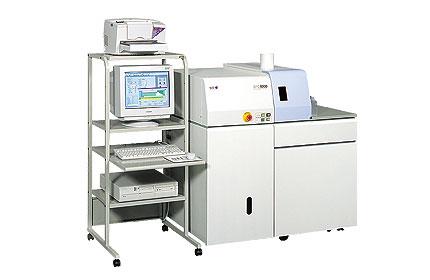|
Instrument Database:
SII Nano Technology Inc. - SPQ9200ev ICP Mass Spectrometer (Environmental Analysis)
| |
|

|
| |
|
| |
|
| Year of introduction |
|
| Status |
available |
| Company |
SII Nano Technology Inc.
|
| Categories |
Mass spectrometer: ICP-MS
|
This is a device that analyzes high-matrix environmental samples, not only tap water, but also industrial drainage with minimized interference in a wide range of concentration with high sensitivity and stability. The acclaimed maintainability of the Q-deflector is effective for environmental analysis.
Features SPQ9000 Series Highlights
- SPQ9000 Series features an all-in one structure with built-in radio frequency generator and vacuum pump, and larger options such as the auto sampler can be placed inside the device, allowing it a minimized installation space. Functions necessary to optimize the device, ion lens voltage, torch location, mass axis calibration, resolution and applied voltage of the detector, can all be adjusted automatically. Also, using the 90 degrees deflector lens (Q-Deflector) enables analysis of high matrix samples such as organic solvents.
- Q-Deflector: Previous versions of ICP-MS were vulnerable against matrix. Major reasons were salt deposits inside the cone and lens contamination. In particular, the ion lens and the mass spectrometer are located inside the vacuum so their maintenance had been a hassle. The Q-Deflector is a breakthrough system that solved the problem of ion lens contamination. Ion, light and neutral components that are pulled from the plasma into the vacuum enter the Q-Deflector formed by four electrodes through the ion lens. The Q-Deflector bends the ion's path 90 degrees and the ion moves to the massspectrometer. Other components pass through the Q-deflector and are removed from the vacuum chamber. With this process, the ion lens is not contaminated by high matrix samples and can maintain a clean condition, preventing diminution in sensitivity and destabilization in measurements caused by contamination.
- Chamber Gas Induction System: One of the problems with ICP-MS had been the interference of molecular ions. In particular, argon-based molecular ions, such as ArO and ArH that forms plasma, forms a high background, deteriorating the minimum detection limit of the affected element. As a result, it was difficult to analyze low concentration of elements such as potassium, calcium and iron that are affected by argon-based molecular ions. By inducting the argon gas from the spray chamber into the plasma, the chamber gas converts it into plasma that is less likely to produce argon-based molecular ions (cold plasma). As a result, it is possible to analyze low concentrations by improving the minimum detection limit of elements such as potassium, calcium and iron.
- This is a system designed primarily for environmental analysis. Designed specially to conduct highly sensitive and stable high matrix sample analysis. By reducing the interference by the molecular ion of the elements in the sample, it adequately handles high matrix samples including tap water, as well as industrial sewage. It adapts a pulse/analog simultaneous detector, and is capable of conducting measurements at a wide range of density of ppt-ppm order. With a data quality control analysis software compliant with EPA200.8 and EPA 6020, accuracy management can be made easily as well.
|
Related links:
|